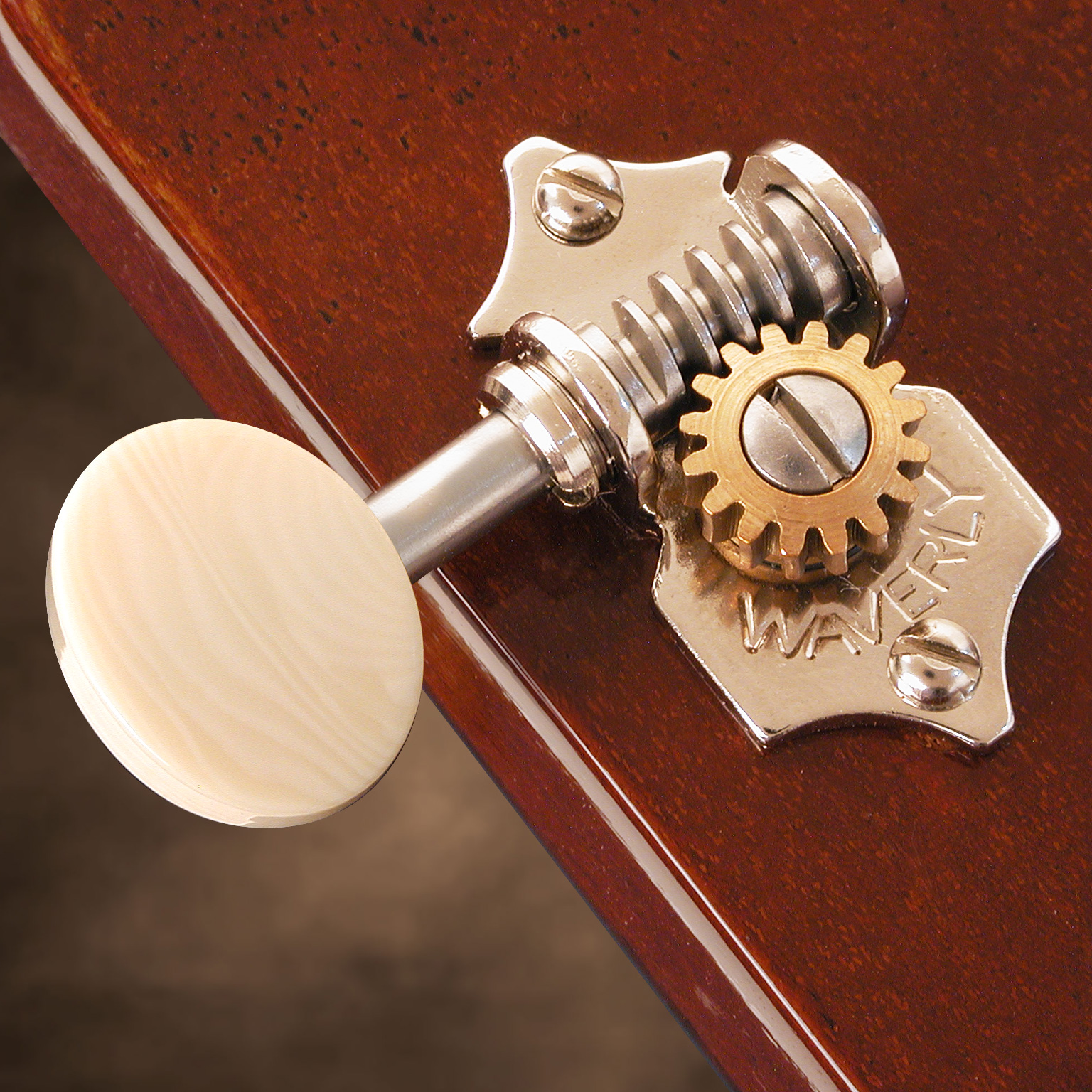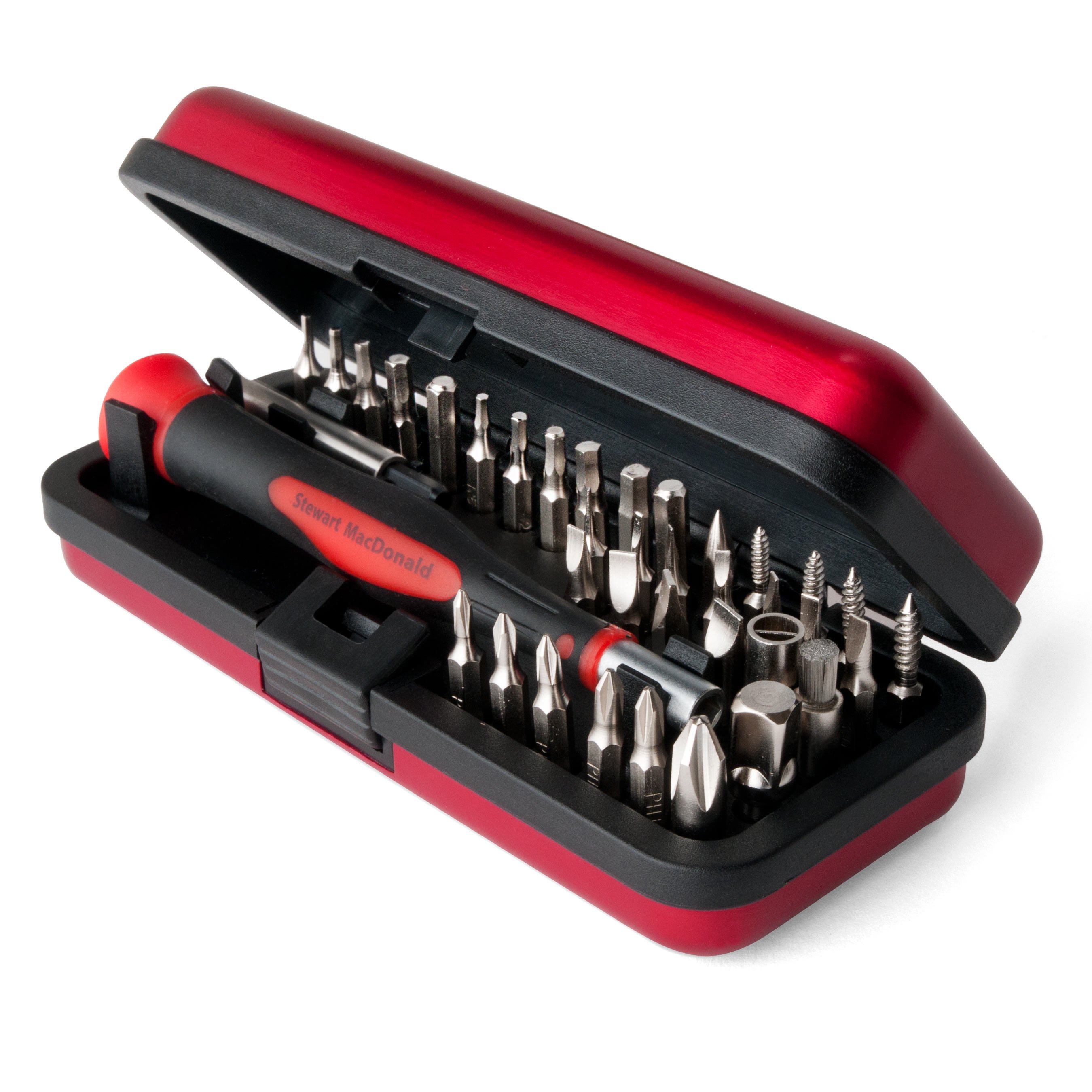Tuning problems fixed + a guitar lesson!
Issue 294 October 19, 2017
This vintage Southern Jumbo wouldn't stay in tune, so Spencer Bohren brought it to Dan Erlewine's shop. The solution is a new set of Waverly Tuners, and Dan shows Spencer how to install them himself -- including a simple way to plug old screw holes. Spencer returns the favor by giving us a guitar lesson.
- Making small plugs out of mahogany
- Getting oil out of old screw holes
- Dan's custom dowel maker: you've probably got one already
- How to play Canned Heat Blues
Video Transcription
[on-screen text reads: Dan Erlewine - Guitar Repairman, Author]
Dan Erlewine: Here's my friend Spencer Bohren of many years. He's a world famous traveling folk musician that just got back from 40 days and 40 nights in Europe [on-screen text reads: Spencer Bohren - Songwriter, Performer], and he brought his old Southern jumbo in because he's having a little trouble with it on that tour.
Spencer Bohren: Let me tell you what's up with this guitar, Dan. You know how much I love this guitar, and it sounds so good. It will play in tune, but it will not stay in tune. It's driving me crazy. After every song, I have to tune it.
Dan Erlewine: I'm for getting rid of these tuners and putting on a set of Waverlys. Those are old tuners. They aren't working well. They don't even look right because the one on this would've had a white button, and these have an ivory button. It looks white enough.
Spencer Bohren: Well, I've tried everything else. Let's do it. Normally, I come here so you work on my guitar.
Dan Erlewine: This is your turn.
Spencer Bohren: 40 gigs in 40 days is a significant amount of work. It's not a vacation, that's for sure. Okay. They're off. Nice box.
Dan Erlewine: Isn't it?
Spencer Bohren: It is nice. Going to keep the box.
Dan Erlewine: This, I would like to ask you if you could put it on the face of your guitar.
Spencer Bohren: Well, how about just on my face? Look at that [on-screen text reads: Waverly Ivoroid Tuners #4065 - stewmac.com]. Wow. Look at those. Now, this'll look perfect. [Spencer sets the new tuners into the peghead holes] It's tight. In fact, the holes line up.
Dan Erlewine: So really, you're going to-
Spencer Bohren: Oh no, this one doesn't line up.
Dan Erlewine: You'll plug six holes.
Spencer Bohren: Let me have another one. Okay, let's just make sure. Here's this... Yeah, that's great [on-screen text reads: Inlay Tracing Scribe - stewmac.com]. That goes right in. That does not. So, we can use this hole, and we have to fill this one. The bottom one.
Cleaning oil out of the old screw holes
Dan Erlewine: Before you get to plug in, you want to clean the holes you're going to plug because there's bound to be oil in there. People oil these tuners for years [on-screen text reads: Behlen Naphtha Solvent - stewmac.com].
[Dan is cleaning out the peghead holes with a pipe cleaner]
Spencer Bohren: Huh? Look at that.
Dan Erlewine: It's dirty, man.
Spencer Bohren: It's dirty. Amazing.
Making small plugs to fill the old screw holes
Dan Erlewine: You can make some little mahogany plugs for the old screw holes. Take the knife and cut the corners off to make it kind of round. You got to get the squares off, then I'll show you a little trick.
Spencer Bohren: Okay.
Dan Erlewine: Fun, huh?
Spencer Bohren: Yeah.
Dan Erlewine: And then, use this dowel maker.
Spencer Bohren: Dowel maker. That looks just like a pencil sharpener we had when I was a kid.
Dan Erlewine: This is a dowel maker.
Spencer Bohren: Okay,
Dan Erlewine: Give her a try. You want to sharpen it?
Spencer Bohren: Yeah.
Gluing in the screw hole plugs
Dan Erlewine: Just like a pencil. Titebond III [on-screen text reads: Titebond III Ultimate Wood Glue - stewmac.com]. I've been using that a lot lately.
Spencer Bohren: Put it in the glue, then put it right on the...
Dan Erlewine: It cleans up with water.
Spencer Bohren: Oh, good.
Dan Erlewine: We're good.
[Dan applies the glue using the dowel then breaks off the tip of the dowel to plug the old tuner screw hole]
Spencer Bohren: That's great to use the plug for the application of the glue.
Dan Erlewine: If it doesn't go down in, we just shave it off with the chisel later. Don't worry about squeeze out.
Spencer Bohren: Okay. Put this in. Pop it off. Wow, that's beautiful.
Dan Erlewine: Hold that chisel firmly and just pare on [on-screen text reads: Two Cherries Wood Chisel - stewmac.com].
Spencer Bohren: Wow. Yeah.
Dan Erlewine: Actually, if you trim them while they're wet, that's good, because they sink back down below the surface when it dries. Carry on. You got four to go.
Spencer Bohren: All right. That's it. Beautiful. What do you think?
Dan Erlewine: I get closer with my thumb and go like this.
Spencer Bohren: Yeah, I don't care if you cut yourself up.
Dan Erlewine: Okay, we're good. Let that dry for a little bit. It's been an hour, man, and do more than dry. This stuff will dry in half an hour-
Spencer Bohren: Yeah, it looks good.
Dan Erlewine: ... if you don't put a load on it. So, put all the tuners on, get all the top screws in, and then we'll line them up and drill for the new ones. Just the way you like.
Installing the new tuners
Spencer Bohren: Okie-doke. I'm going to use the old screws.
Dan Erlewine: Cool.
Spencer Bohren: Is that okay?
Dan Erlewine: The new screws are actually made better, but I know what you want. That's okay. Save the screws though. What I like to do, I'm not going to be pushy, but I like to put my fingers around it when I do it. So if I slip, at least to hurt myself, not the finish. A little trade secret.
Spencer Bohren: Why don't I put your fingers around it? Okay.
Dan Erlewine: Just do one. I think that's the right size bit. This is a little depth stop that sets you from going too deep.
Spencer Bohren: So, I go all the way to the bottom?
Dan Erlewine: Yep.
Spencer Bohren: It's fun this luthiery.
Dan Erlewine: Yeah, it is. Come off the road and work for a while. Real work.
[Dan hands Spencer a screwdriver and he starts screwing in the new tuners]
Spencer Bohren: Real work, yeah. Oh right, we got to string it [on-sreen text reads: Guitar Tech Screwdriver Set - stewmac.com]
Dan Erlewine: You've got to go to Fur Peace and play.
Spencer Bohren: That's true.
Dan Erlewine: And you have to have this done before you can do that.
Spencer Bohren: Everything is a snug.
Dan Erlewine: Cool. String it up. I'm hoping if you'll have time before you leave, give us a lesson, sort of like you might give at Fur Peace.
Spencer Bohren: Okay, cool. Yeah, cool. Well, these tuners are... They really are different, aren't they?
Dan Erlewine: They're tighter for sure.
Spencer Bohren: Yeah. They tune a little bit slower and a little more accurately.
Dan Erlewine: The little finer ratio than you are used to.
How to play Canned Heat Blues
Spencer Bohren: All right. So, you were asking what I might teach at the Fur Peace this weekend. One thing I really like to teach is the tunings, because they make the guitar sound different. I might tell everybody in the class, this year, there's 14 students to tune down their E string a step. One step like... So then, when you play that D chord, it's got some meat to it like a D normally doesn't have.
And then, I would show, I really love the song Canned Heat Blues from the 1920s by Tommy Johnson. It's built on this little guitar figure that goes like this. We get everybody in the class doing this. It's on the and one, and one. When everybody can do that, then we start getting them to do this. Once everyone can do that, we put them together like this. And then, once everybody can do that, then we go to the G. Back.
What I'd like to say is that it's simple but not necessarily easy. And so, we're playing simple music. You end up with the Canned Heat Blues, which sounds like this and everybody sings it too.
[Spencer playing his acoustic guitar and singing the Canned Heat Blues]
I might teach them a little guitar run like this.




